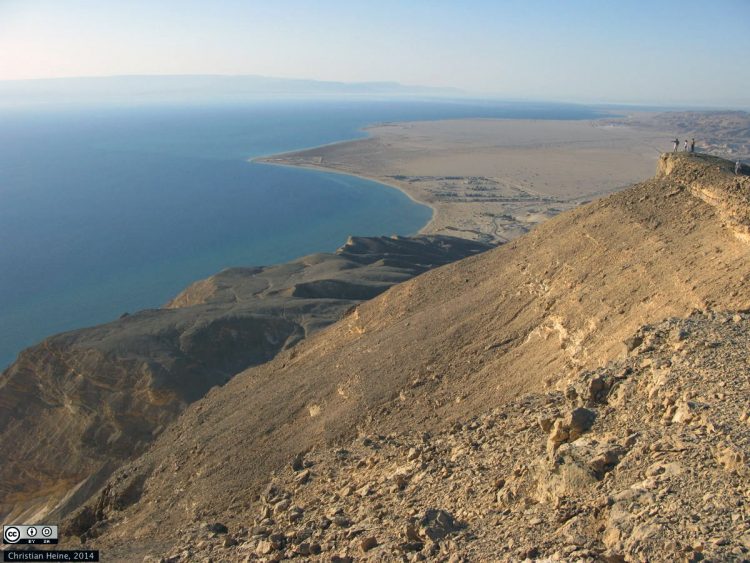Asymmetric continental margins and the slow birth of an ocean

"A newborn ocean. Only few tenths of kilometres separate the massive rift shoulders of the Sinai-Peninsula from the African continent on the far side of the Gulf of Suez. 130 Million years ago, the young South Atlantic ocean has likely looked similar (Image: Christian Heine, University of Sydney, under Creative Commons)"
The continental margins formed through this separation are surprisingly different. Along offshore Angola 200 km wide, very thin slivers of continental crust have been detected, whereas the Brazilian counterpart margin features an abrupt transition between continental and oceanic crust.
For decades, geoscientists have struggled to explain not only why the amount of thinning and the geometries of opposite rifted continental margin are not symmetric, but also why wide margins are often underlain by highly thinned continental crust.
Now geoscientists from the German Research Centre for Geosciences (GFZ), the University of Sydney and the University of London have found an explanation, published in the current issue of 'Nature Communications'. Using high-resolution computer models and geological data from the South Atlantic margins, they discovered that the centre of the rift, where the continental crust gets actively thinned through faulting, does not stay fixed during continental break-up, but migrates laterally.
“We could show that rifts are capable of moving sideways over hundreds of kilometres”, says Dr Sascha Brune of the GFZ. “During rift migration, the crust on one side of the rift is weakened by hot upwelling material in Earth's mantle, whereas the other side is slightly stronger as the crust there is colder.
New faults form only on the warm, weak rift side, while those of the strong side become inactive.” This leads to a sideways motion of the rift system, which is equivalent with conveying crustal material from the South American plate to the African plate. These transferred crustal blocks are strongly extended by the rift and finally constitute the enigmatic thin crustal slivers of the African margin.
Such a relocation of a rift takes its time: during the formation of the present-day Angolan and Brazilian margins, the rift centre migrated more than 200 km westward. This delayed continental break-up and the generation of oceanic crust by up to 20 million years.
The new models reveal that extension velocity plays a crucial role in understanding the widths of South Atlantic margins: faster crustal extension leads to longer rift migration and hence to more pronounced asymmetry of the generated continental margins.
Rifts constitute an important tectonic element of our planet. They are responsible for the shape of today's continents, and their activity still continues at present.
Illustrating a new aspect of plate tectonic theory, this study shows that during continental break-up, large amounts of material can be conveyed from one side of the plate boundary to the other, a process that has not been yet accounted for. The new models and analyses provide an important stepping-stone toward a comprehensive understanding of rift processes and continental margin formation.
Brune, S./Heine, C./Marta Pérez-Gussinyé, M./Sobolev, S.: “Rift migration explains continental margin asymmetry and crustal hyper-extension”, Nature Communications. 5:4014 doi: 10.1038/ncomms5014 (2014), 06.06.2014
Media Contact
All latest news from the category: Earth Sciences
Earth Sciences (also referred to as Geosciences), which deals with basic issues surrounding our planet, plays a vital role in the area of energy and raw materials supply.
Earth Sciences comprises subjects such as geology, geography, geological informatics, paleontology, mineralogy, petrography, crystallography, geophysics, geodesy, glaciology, cartography, photogrammetry, meteorology and seismology, early-warning systems, earthquake research and polar research.
Newest articles

Simplified diagnosis of rare eye diseases
Uveitis experts provide an overview of an underestimated imaging technique. Uveitis is a rare inflammatory eye disease. Posterior and panuveitis in particular are associated with a poor prognosis and a…

Targeted use of enfortumab vedotin for the treatment of advanced urothelial carcinoma
New study identifies NECTIN4 amplification as a promising biomarker – Under the leadership of PD Dr. Niklas Klümper, Assistant Physician at the Department of Urology at the University Hospital Bonn…

A novel universal light-based technique
…to control valley polarization in bulk materials. An international team of researchers reports in Nature a new method that achieves valley polarization in centrosymmetric bulk materials in a non-material-specific way…





















